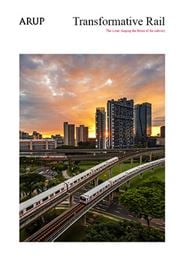The ambition to move towards more responsible production and consumption is at the basis of the circular economy. Two Arup leaders discuss how implementing the circular economy approach can help asset management, one of the major challenges of the rail industry.
-
Carol Lemmens, Advisory Services Global Leader, Arup
-
Andrew Went, UKIMEA Rail Business Leader and Global High Speed Rail Leader Arup
What do we mean by circular economy?
CL: Circular economy is restorative by design: it aims to keep products, components and materials at their highest utility and value, at all times. Our analysis of case studies around the world indicates that circular economy is still primarily implemented at the design stage, focusing on the use of recyclable, renewable or biodegradable materials. But this is just the first step: equally important are new business models and understanding how operations influence the health of assets.
To the rail industry, is the circular economy a potential headache?
AW: The implementation of circular economy challenges us to modify our thinking (and to reconsider some of the regulations), but the concept is not totally new to the rail sector. Take the use of resources as an example. Rail structures are designed for longevity, which means that the selected materials need to be very durable; in many cases, once the assets reach the end of their life cycle, the materials can be recycled and reused (for example, rails are reused for sidings and areas where trains travel at slow speeds, or concrete sleepers might be cut in half for use on miniature railways).
We also see a gradual shift towards design for disassembly, especially in the case of new stations. Take the Cityringen stations in Copenhagen, which combine beautiful design with the practicality of a modular approach. The replacement of single elements becomes easier and more accessible, which may open avenues for the use of less durable, but bio-based or biodegradable materials, as long as they meet the safety standards.
CL: Circular Economy is increasingly geared towards renewable energy options, e.g. for transport. Incineration of residual waste to obtain electricity – a practice that should be applied only after all possible other options for reuse and recycling have been explored – is an example of extracting value from resources that, in a usual linear economy model, would end up in landfill.
The potential of resource use and reuse is clearly huge. How do we unlock this potential?
CL: For any system under consideration, a careful documentation of the composition and the provenance of materials is a prerequisite to subsequent upcycling, regeneration or reuse. This operation can be carried out using technologies like radiofrequency identification (RFID), while digital platforms can be used to store and access the data.
For the whole system to function, the information needs to be regularly updated; only this way will the conditions of an asset be transparent. The asset itself may then become the source of raw materials. We are keen to identify the potential for a second or even third life of a component, but to do so, we need to know about its deterioration over time.
Isn’t this the same type of information that the rail industry requires to manage assets in a more efficient way?
AW: Indeed, there are some similarities between the requirements for the successful implementation of a circular economy approach and efficient asset management, but I would be careful not to underestimate the challenge. I believe that digital technologies have enormous potential, but they need to be supported with a change in working practices. In both asset management and implementation of circular economy the availability of accurate data and a thorough understanding of the asset-operations relationship are essential. Ultimately, however, it is down to people: asset managers and asset operators need to commit to using these tools.
What about the historic assets where not all information is available?
CL: This is a challenge that is recognised by many sectors; available data is often patchy and scattered. In some cases, we can use technology to evaluate the status quo and initiate regular data collection. Some of it will remain unknown and we will need to plan for this uncertainty. The key, however, is to make sure that the information out there is integrated and reaches the people who need it.
AW: Creating accessible systems that enable us to store and access the information is a first step towards better asset management. The fact that it also aids implementation of circular economy is another argument in its favour.
-
Expertise
Digital asset management
As the physical and digital worlds converge, there are powerful new ways to manage, operate and optimise your buildings and assets across their entire lifespan. Arup is helping clients to bring transformative asset analytics and intelligence into their operations.
-
Expertise
Rail
From a single commuter journey to a country’s wider economy, rail can transform lives, businesses and communities. Arup has over 60 years’ experience delivering rail projects for clients in the public and private sectors, across the world.
-
Expertise
Circular economy
Arup is helping their clients unlock opportunity and preserve value by ending the practice of make, use, dispose with circular economy planning and values. Discover how we can help you.
 ;
;

